|
Common
and Village Indian Dogs
The Common
Indian Dogs and Village Indian Dogs; The common Indian Dogs where actually
the same type (breed) as the Village Indian Dogs. Same size, same personality,
just a thicker undercoat in the Northern Common (Village) Dogs and thinner
shorter coats in the Southern Common Indian Dogs. These dogs were known
as the Common Indian Dogs because they were the most Common and more dispersed
around the North and South American continents. The other types were more
concentrated within their respective areas. Although the Plains Dogs were
also found in all the other areas too, but mostly in the Plains.
|
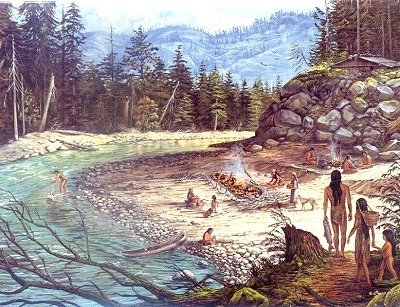 Typical
Common type Indian Dog
Typical
Common type Indian Dog
in the Oregon River areas
|
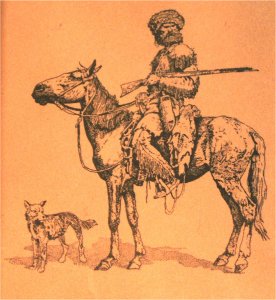
Old
Mountain Man with his Indian Dog,
slightly taller than Plains
|
|
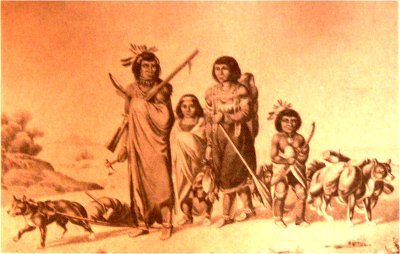
The Common types were referred to
as Village Dogs in the north
|
Of
all the six slightly different working types (breeds), the Common and Village
Dogs were the largest, 2” taller than the Plains type, but never over
55 lbs. Plus more than the other types they can even still be found in there
original areas, far more easily than the almost, if not completely extinct
Hare, Plains, Tahltan and Pueblo Dogs. |
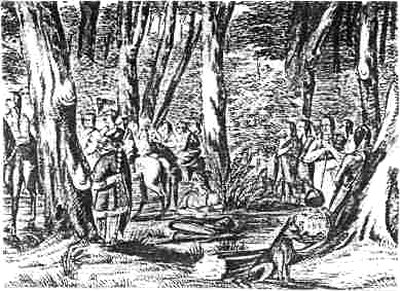 The Common
types were more 'sight' hunters
The Common
types were more 'sight' hunters
in the forest areas
|
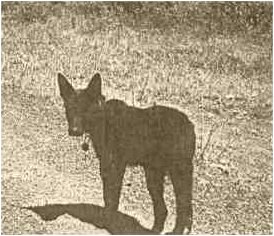
Black Bear - one of the first dogs in the
foundation lines of American Indian Dogs
|
| Not
too long ago , the American Indian Dog Registry found a very good Common
Indian Dog example in South America, called street dogs, that live a semi
feral life on the streets of large citys. Plus some Aztec Indians still
use them for herding cattle and sheep. Also two Northern Village Indian
Dogs that were used for long distance sled dog racing that are very good
examples of the Common Northern types. Most of the Village Indian Dogs have
now been assimilated into the “catch all” Alaskan Husky registry.
The street dogs of South America are very similar to the primitive, feral
street dogs in India, that are related to the old primitive aboriginal dogs
of that part of the world. And let's not leave out the old primitive Dogs
in Australia, the Dingo’s. |
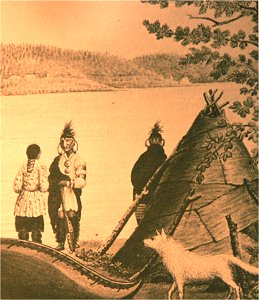 Blond
sable – Northern type Common dog,
Blond
sable – Northern type Common dog,
found with the Klamath Indians
|
|
|
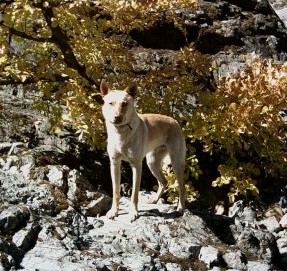
Medicine Bow, a blond
cream/silver sable -
(Commons have shorter hair than the Northerns)
|
All
of these primitive dogs are probably, to one extent or another, related
or have very similar ancestors. The only difference is that Native Americans
also developed their dogs from crossing in coyotes thousands of years ago.
Where as the dogs from Africa, India and Asia used jackals and small Asian
wolves that are more Jackal-like than wolf-like. With modern DNA and logical
research, it’s now known that the wolf was not the ancestor of the
modern dog, but coyote and jackals were the modern dog's ancestors. Outdated
research said all people and dogs migrated into the American continents
across the Baring Straits. New, more recent research shows they also came
up from the south. |
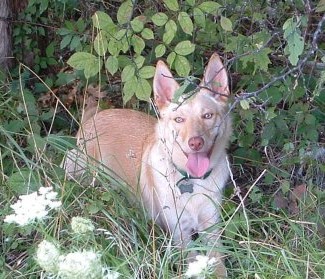
Typical look of Old Common blood lines within the modern
American Indian dog breed
|
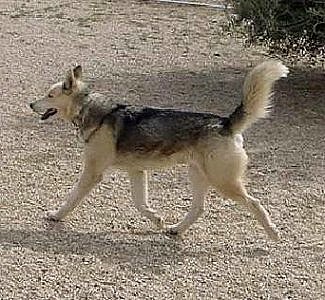 Notice
same color, size and markings
Notice
same color, size and markings
of the Old Oregon Common Dogs
|
| Common
Indian Dogs are closely related and also used to create the Plains Indian
Dogs. They ranged from the Village and Inuit Dogs in the North, Canada and
Alaska with the thicker, heavier under coats to the Sioux Dogs with more
medium coats and down into the Americas with the thinner shorter coats.
They were used for most of all the same purposes as the Plains Dogs, but
more for pulling sleds through the snow in the north. |
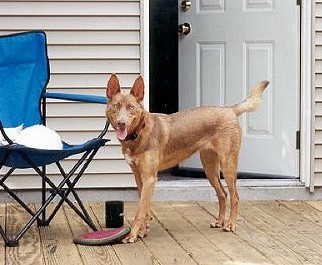 This modern
American Indian Dog shows the
This modern
American Indian Dog shows the
shorter hair of the more Southern types
|
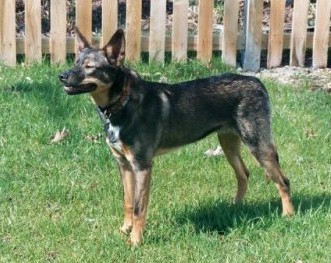
Typical color, markings and hair length
of the Common Indian Dog, new and old
|
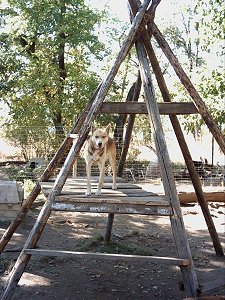 Arrow,
a breeding female, typical Common
Arrow,
a breeding female, typical Common
type look of modern American Indian Dog lines
|
 Old Village
type, used for pulling and hunting
Old Village
type, used for pulling and hunting
(notice sable markings)
|
They
had a very slight build like the other types, just taller. Long legged,
similar looking to the Pharoah Hound, slender skull with high forehead
and a knife-like sagittal crest or bump on the top skull, slender frame
with lower slung chest. Large sharp erect ears. Thicker undercoat in the
North and thinner silky or satiny in the South. Coat colors are the same
as the Plains Dogs, agouti ticked (sable) in all colors. Two inches taller
than the plains Dog, 20” to 22” at the shoulders and 55 lbs
weight at the most. Light yellow, gray or blue eyes.
|
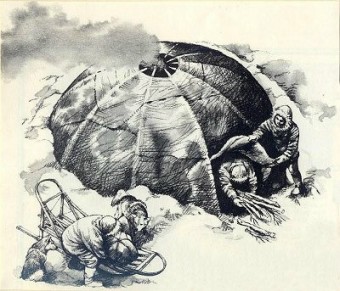
Village Dogs where used for keeping warm
at night – (a 7 Dog Night)
|
The Old
Northern Village Dogs were more
Collie-like than the modern Husky
|
| Besides
the numerous accounts from The Elders, there are many archeological remains
found. There were three crania from Madisonville, Ohio, two from La Moine,
Maine, fragmentary skulls from Cuba, a skull from Peel River, Yukon, three
complete skeletons at Slatford, Co., and one from Santa Barbara Island off
the California coast. These remains and descriptions confirm the wide spread
presence of the Common Indian Dog and Village Indian Dogs over the vast
North and South American continents. Most of these carbon dated to over
12,000 years ago. |
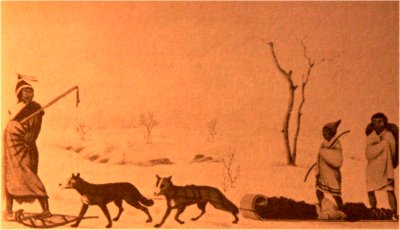 The Chippewa
had the typical Old Northern Village type Indian Dogs
The Chippewa
had the typical Old Northern Village type Indian Dogs
|
 Northern
Village Dogs were used for
Northern
Village Dogs were used for
guarding, hunting and pulling
|
Old Village
Dogs had color down their muzzle
and spots above eyes
|
 You can
still see the Old Village Dog
You can
still see the Old Village Dog
in some modern lines
|
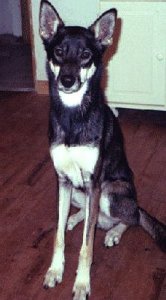 This American
Indian Dog shows the color
This American
Indian Dog shows the color
markings of the old bloodlines.
|

M ost Old
Village Indian Dog lines are lost within
the Alaskan Husky breed.
|
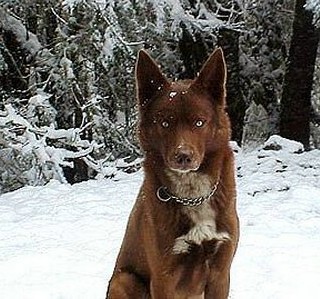
Koda
Chan, a blue eyed modern American Indian Dog who shows the Northern
Village lines.
|
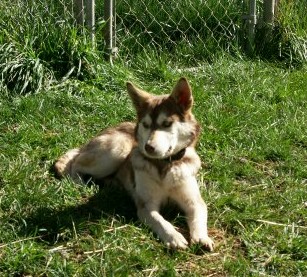 Nickia,
a female American Indian Dog has same markings as the Old Village Dogs
Nickia,
a female American Indian Dog has same markings as the Old Village Dogs
|
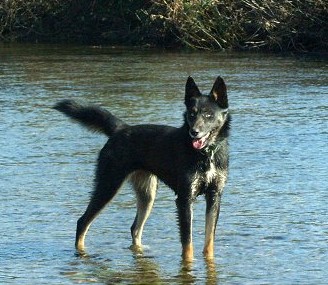
Sierra”
has that Old Village Indian
conformation for pulling and running
|
| |
|
|
Since
Common Indian Dogs were used in the mix (recipe) called Plains Indian
Dogs, we have also used them in the modern day indian dogs, maintaining
bloodlines of the Common and Village Indian Dogs within our American Indian
Dog breeding program, for our recipe variables, to take our breed into
the future and to maintain it's variability with newer outcrosses available.
Click
on the links below to see articles and photos of both the
old and new American Indian Dogs.
|






















